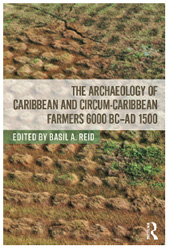 |
 |
 |
|
September 2018
|
Digging up the farm
According to the publishers, Routledge, it spans “a wide geographic reach stretching from the Florida Keys in the north to the Guianas in the south,” and “places a well-needed academic spotlight on what is generally considered an integral topic in Caribbean and circum-Caribbean archaeology.” “The book explores a variety of issues, including the introduction and dispersal of early cultivars, plant manipulation, animal domestication, dietary profiles, and landscape modifications. Contributors discuss their findings within multiple constructs such as neolithisation, social interaction, trade, mobility, social complexity, migration, colonisation, and historical ecology. Multiple data sources are used which include but are not restricted to rock art, cooking pits and pots, stable isotopes, dental calculus and pathologies, starch grains, and proxies for past environmental conditions.” It is available online. Dr. Basil Reid is a Senior Lecturer in Archaeology, in the Department of History at The UWI, St. Augustine. |


 “This volume focuses on how early native communities in the region practised various forms of agriculture from 8,000 years ago to the period of European contact. Given its multiple case studies and its discussion of state-of-the-art technologies, the book should be of immense value to archaeologists, ecologists, biogeographers and agriculturalists,” says Dr. Basil Reid, the editor of the 17 chapters covered in “The Archaeology of Caribbean and Circum-Caribbean Farmers 6000-BC–AD 1500.”
“This volume focuses on how early native communities in the region practised various forms of agriculture from 8,000 years ago to the period of European contact. Given its multiple case studies and its discussion of state-of-the-art technologies, the book should be of immense value to archaeologists, ecologists, biogeographers and agriculturalists,” says Dr. Basil Reid, the editor of the 17 chapters covered in “The Archaeology of Caribbean and Circum-Caribbean Farmers 6000-BC–AD 1500.”